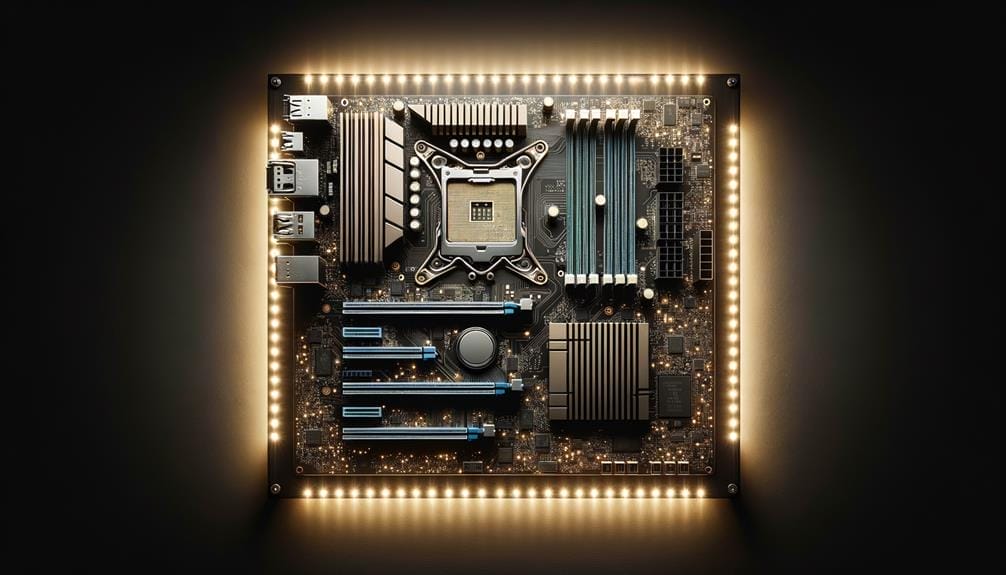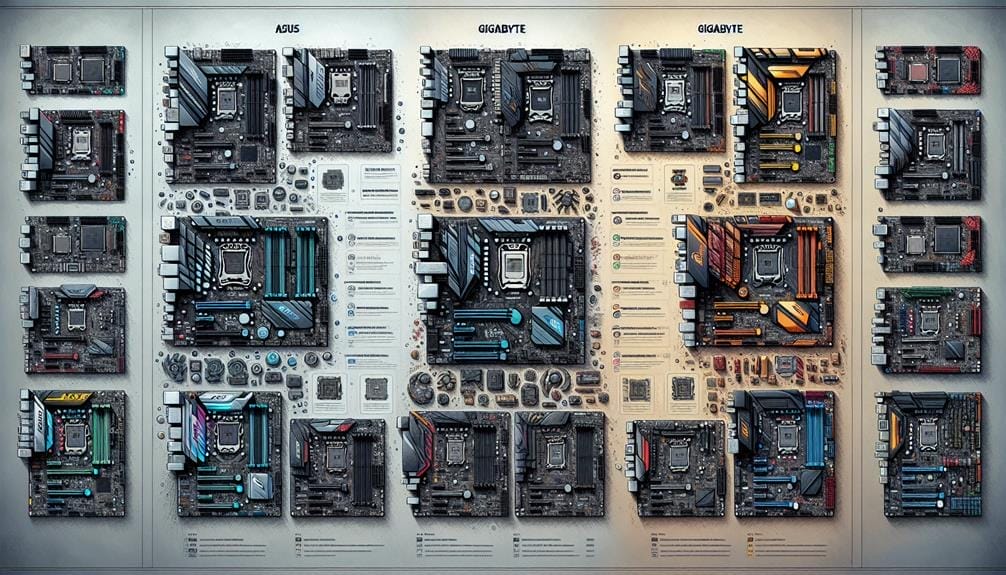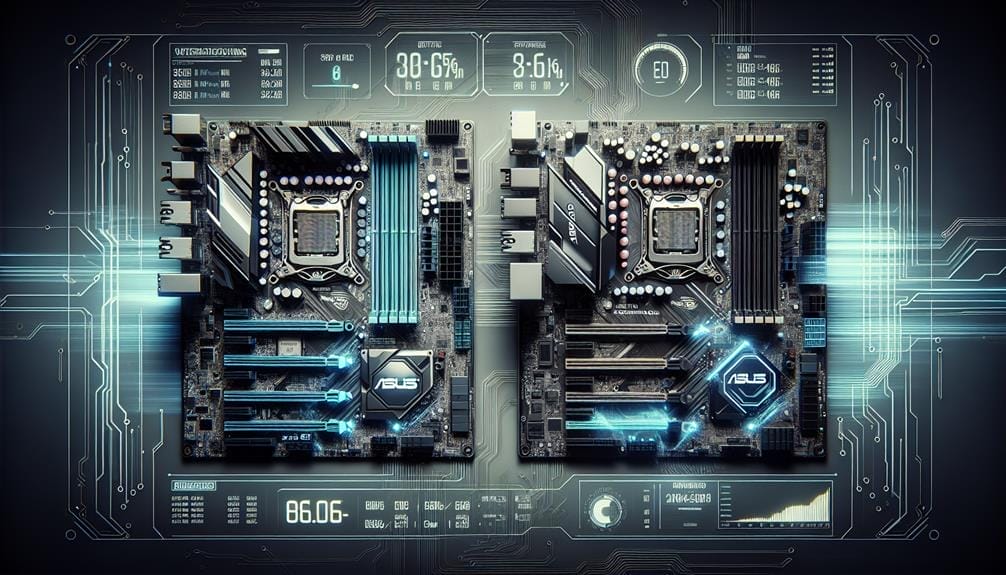ASUS Vs Gigabyte: Motherboard Titans Clash

Within the constantly changing world of computer parts, the competition to be the top motherboard manufacturer between ASUS and Gigabyte attracts significant interest. These firms are celebrated for their deep understanding of technology and their steadfast dedication to fostering innovation.
As we explore the intricate details of their motherboards, it becomes apparent that the competition between these industry giants extends beyond mere brand loyalty. The nuances of their respective offerings, spanning from features and performance to market suitability, provide a compelling narrative that demands meticulous evaluation.
This article aims to dissect the ASUS vs Gigabyte motherboard clash, offering a comprehensive analysis that sheds light on the defining factors that set these titans apart.
Key Takeaways
- ASUS and Gigabyte are both reputable PC hardware manufacturers with a global presence.
- Both brands offer reliable and durable motherboards, with ASUS known for functionality and Gigabyte known for durability.
- ASUS has a wider variety of choices in form factor support, including Mini ITX and Micro ATX options.
- When it comes to overclocking, ASUS provides more affordable options for entry and mid-range pricing, while Gigabyte performs better in high-end CPU overclocking performance.
Company Background and Global Presence
Both ASUS and Gigabyte have established themselves as prominent global players in the PC hardware industry. They have extensive resources and a widespread presence in the market.
ASUS, founded in 1989, has a rich company history. It is renowned for manufacturing a wide range of PC hardware, including motherboards, monitors, GPUs, and laptops.
Gigabyte, founded in 1986, has also made a significant impact with its primary focus on durable and reliable motherboards.
The market competition between these two companies has been fierce. Both brands compete to provide high-quality products and innovative technologies to cater to the diverse needs of consumers.
This competition has driven continuous improvements and advancements in the PC hardware industry. As a result, consumers benefit from a wide array of choices and cutting-edge technologies.
Evaluation of Motherboard Quality
When assessing motherboard quality, it is essential to conduct a comprehensive and impartial evaluation of the performance, durability, and reliability of individual models offered by ASUS and Gigabyte. Evaluation criteria should include factors such as overclocking capabilities, component durability, power delivery, and BIOS features.
Additionally, customer reviews play a crucial role in understanding real-world performance and reliability. ASUS generally receives positive feedback for its reliable and functional motherboards, while Gigabyte is known for providing durable and reliable options.
Both brands offer a wide range of motherboards at various price points, catering to different market niches. Therefore, it is crucial for users to consider their specific needs, read customer reviews, and compare the features offered by both ASUS and Gigabyte before making a purchase decision.
Product Lineup and Market Niches

ASUS and Gigabyte each offer a diverse product lineup tailored to specific market niches in the motherboard industry.
- Market Segmentation
- ASUS targets a wide range of consumers, from budget-oriented builders to high-end enthusiasts.
- Gigabyte focuses on durability and reliability, appealing to users seeking long-term performance and stability.
- Target Audience Analysis
- ASUS caters to gamers, content creators, and mainstream users with a wide range of options and features.
- Gigabyte’s emphasis on durability makes it an attractive choice for system builders, businesses, and those seeking long-term reliability.
Both brands effectively segment the market, offering options for various user needs and preferences. This market segmentation allows ASUS and Gigabyte to effectively target different consumer groups, ensuring that their product lineups meet the diverse demands of the motherboard market.
Comparison of Form Factor Support
The diversity of form factor support is a key differentiator in the motherboard offerings of ASUS and Gigabyte.
Both brands support ATX, Micro ATX, and Mini ITX form factors, with ASUS offering a larger variety of choices.
ASUS and Gigabyte also offer support for E-ATX, ATX, Micro ATX, and Mini ITX. Differences in features and connectivity may be observed in their offerings.
ASUS provides a wider product stack with more options, especially for Mini ITX and Micro ATX builds. This indicates a more extensive form factor compatibility.
Therefore, users seeking specific form factor support should carefully consider the differences in form factor compatibility, features, and connectivity between ASUS and Gigabyte motherboards before making a purchase decision.
Overclocking Capabilities and Performance

Comparing the overclocking capabilities and performance of ASUS and Gigabyte motherboards reveals distinct differences in their offerings for enthusiasts and power users.
- CPU Compatibility
- Both ASUS and Gigabyte offer motherboards with CPU overclocking support.
- ASUS provides cheaper overclocking-capable boards compared to Gigabyte.
- Pricing and Value for Money
- Gigabyte performs better in overclocking performance in high-end CPU overclocking boards.
- Verdict: ASUS for entry and mid-range overclocking pricing, Gigabyte for overclocking performance in high-end CPU overclocking boards.
Both brands cater to different segments of the market, and the choice between ASUS and Gigabyte for overclocking capabilities ultimately depends on specific CPU brand preferences and budget considerations.
Conclusion and Recommendations
The disparities in overclocking capabilities and performance between ASUS and Gigabyte motherboards highlight the need for a comprehensive assessment to provide suitable conclusions and recommendations for users and enthusiasts. When making a purchasing decision, factors such as the country of purchase and RMA policy/quality should be considered.
ASUS offers a wider product stack with more options, especially for Mini ITX and Micro ATX builds, while Gigabyte excels in providing quality options for AMD CPUs. High-end gaming boards from both brands are compelling, with Gigabyte’s AORUS Extreme and ASUS’s ROG Series recommended.
ASUS’s Creator and Workstation-oriented boards offer improvements in multi-GPU performance, Thunderbolt support, and running multiple NVMe M.2 SSDs. Ultimately, there are no real reasons to pick or avoid one brand over the other as both ASUS and Gigabyte manufacture quality motherboards.
The recommendation is to focus on a specific market segment and read real reviews of narrowed down motherboard choices.
Conclusion
In conclusion, the comparison of ASUS and Gigabyte motherboards reveals a nuanced landscape of features, performance, and market suitability.
Both companies have established themselves as leaders in the industry, offering a diverse range of products to cater to various consumer needs.
The evaluation of motherboard quality, form factor support, and overclocking capabilities demonstrates the strengths and weaknesses of each manufacturer.
Ultimately, the choice between ASUS and Gigabyte motherboards depends on individual preferences and specific use cases.

